WordPress for Enterprise: The 1 Million Euro Website

In the hands of the right agency, WordPress can be a very powerful CMS or even Digital Experience Platform for Enterprises – but it takes some effort and a lot of knowledge to do so.
WordPress is under permanent transformation, going from it’s early years as a blogging software to a full grown CMS with many features and customization options for any need. This article highlights how some of the biggest WordPress websites are developed and what makes the difference to the default installation. In the hands of the right agency, WordPress can be a very powerful CMS or even Digital Experience Platform for Enterprises – but it takes some effort and a lot of knowledge to do so.
This blog was originally a speech of our colleague Giuseppe Mazzapica on the WordCamp Catania in September 2019. It contains spoken word and is a long read. But it’s totally worth it.
I am a developer, and even if this is the 8th or 9th time I speak at a WordCamp, it is the first time I give a talk on the “business side” of WordPress topics.
Fearing that no one would believe a developer talking about business, I chose this very catchy title in the attempt to not give a talk in front of an empty room.
So, before we start, I owe an apology to anyone being here to find out how to earn 1 million euro by making a WP site, because the real topic of the talk is “WordPress in the enterprise market”.
Table of Content
Do WordPress websites that cost 1 million Euro exist?
But we are used to very different numbers.
Democratized publishing (and its side effects)
WP products can be moved to the enterprise. Or not.
Automattic and the Enterprise Market
Do WordPress websites that cost 1 million Euro exist?
Yes, they do. Without going into the details of development costs, only the hosting for a website could cost up to 20.000 € per month – per installation.
The example in the slides refers to an 18 months contract (6 months of development before going live, plus one year of additional development and maintenance), for two installations. So up to 720.000 € could be spent by an enterprise client just on hosting.
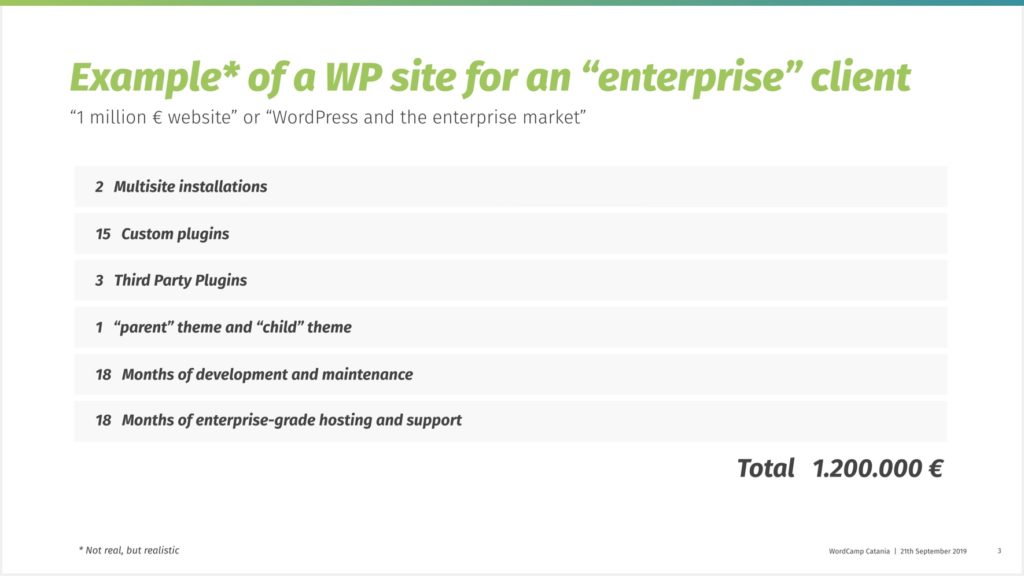
But we are used to very different numbers.
There are a lot of marketplaces for WordPress plugins and themes where you can find a plugin for 100 € or a theme for 90 €.
Please note that I have done no market research, so please don’t see the numbers as digits. This is about the order of magnitude, not cents.
And it is clear that it is possible to build a website by putting together a few plugins, a theme, and a couple of months of a freelance developer “customizing and adjusting” which satisfies the requirements of a small company and costs them a few thousand euros, at max.
That website, in terms of features and the amount of code, will not be very different from the enterprise example of before, and WordPress will be the same WordPress.
So, why is there such an enormous difference?
Obvious things first
If I go to a shopping mall, maybe during the sale season, I can buy a man suit for something like 50 €. If I go get a tailored suit, I can spend a few hundred euros or more. If I ask a famous stylist for that, I can spend several thousand.

The old, obvious story of quality VS quantity.
But there’s more. Why on earth should someone (besides the fact they simply can) spend thousands of Euro on something that one can get for 50 €?
Because they care.
If the next-door little shops website goes down for two hours, probably nobody even notices.
If an international company website goes down two hours, there will be millions lost, hashtags on Twitter, newspaper headlines, people could lose their jobs.
The website is a high-value asset for enterprises. So they need to be sure to get it from known and skilled stylists, not on sale in a shopping mall. And that is expensive.
Now, the question that might arise is: Is a WordPress website something from a shopping mall or a skilled stylist?
Let’s keep this question pending for a while, and let’s try to understand some peculiarities of the WordPress market position.
Democratized publishing (and its side effects)
Since the beginnings of WordPress democratize publishing has been its motto and mission, and 16 years later we can definitively say that this mission has been accomplished. More than a third of the web runs on WordPress and it is by far the most popular CMS on the market.
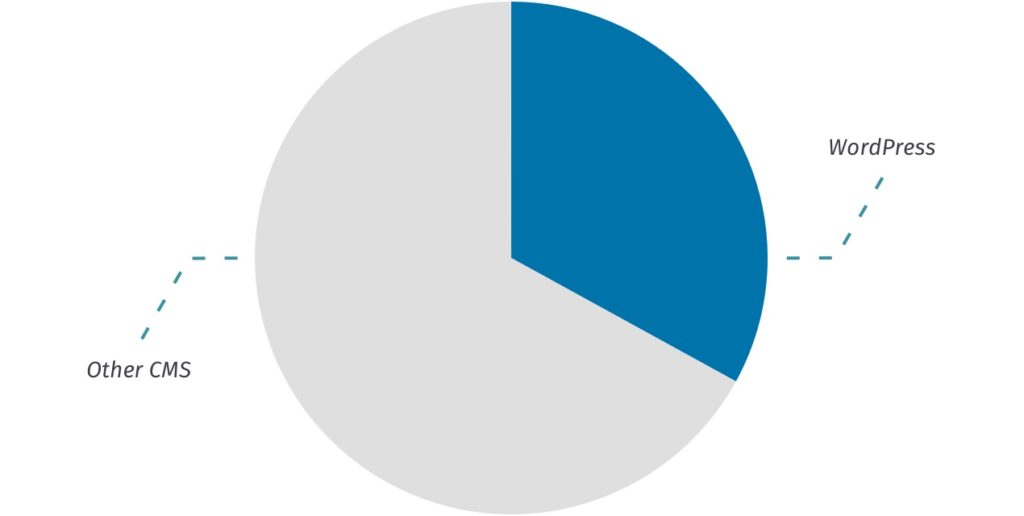
But how did WordPress do it?
I think that WordPress achieved that goal by removing technical responsibility from site owners: you do not need to be tech-savvy to own a WordPress site, and you don’t need to be that tech-skilled even to “develop” or maintain WordPress sites.
This had a positive impact on the whole web, but also had other consequences: A (huge) market was created in which hundreds (perhaps thousands) of companies make considerable profits having buyer personas for their products like the unskilled amateur, the semi-professional “site implementor”, or the hobbyist blogger.
Not saying this is bad. At all. But I think it is “anomalous”.
Let me give an example.
I have a driving license for 20 years. Yet, I understand nothing about motors. If my car stops broken in the middle of the street, besides looking under the hood and see the engine is still there, there’s very little I can do. I need to go to a professional who knows what to do. They will use tools and spare parts to solve my cars issues. The companies that conceive, build and market those tools do not expect that there’s an unskilled person (me) on the other side of their marketing, they expect a pro. And having in mind a pro as the buyer persona they design, create and market those tools.
On the other hand, the by far great majority of the WordPress products are conceived, developed and marketed for non-technical, amateur, non-skilled buyers. And this is kind of peculiar. The target of their products are not end-users, people who just visit or use the website (drive a car), but people who maintain and develop a website (do maintenance for the car).
Don’t get me wrong: some of the mass-market WordPress products have good quality, some very good developers work for companies that make profits selling them. But, if you talk with them, something they are often concerned about is having “too technical” solutions for their products.
This whole situation, even if “anomalous”, has proven to work very well for a gigantic number of users and companies. It just doesn’t work in the enterprise market …
WP products can be moved to the enterprise. Or not.
A lot of the thousands of available WP plugins are free to install and use. When users install a few of them, their WordPress dashboard becomes a market: Plugins asking to upgrade the account, donations, a recommendation, a newsletter subscribing, a five-star review.
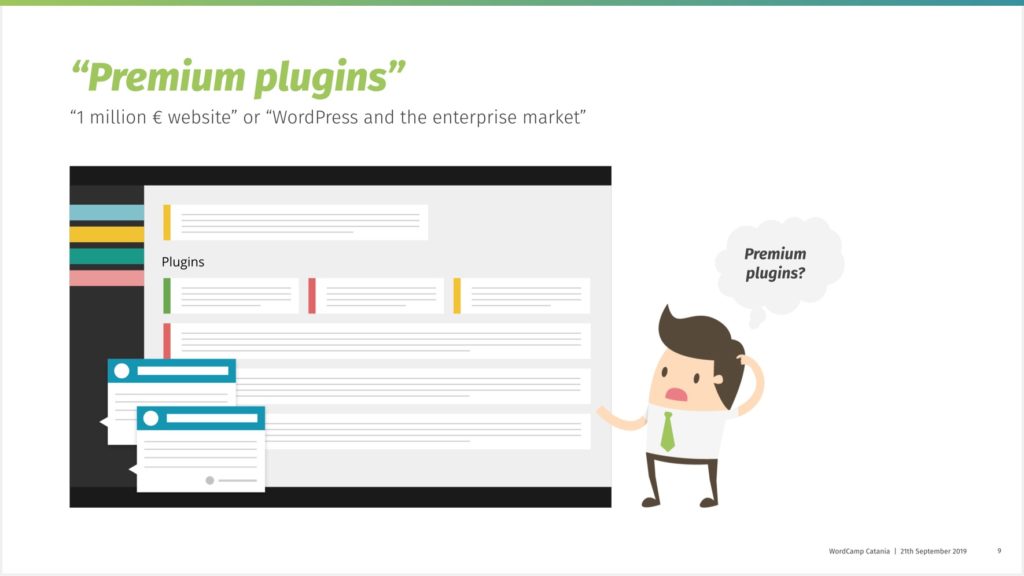
As I already said, the target market is consumers. So, it is no surprise that companies are doing consumers’ marketing. And that “kind of” works for that market. But imagine being a manager of the fictional company described at the beginning that is spending more than one million for a website and logging-in found such a dashboard … of course, that’s not acceptable.
Don’t use free plugins then, right? Premium plugins are better at this, no? Well, I have a first-hand anecdote for you.
Some time ago, one big client of Inpsyde, required a new feature on their website. Their timeline was very tight. Too tight to build a custom solution. Their architect proposed to look at the available plugins on the market. To make it short, we ended up using an existing premium plugin.
At first, everything went well.
One month later, the client asked for an additional feature related to the plugin. We asked the plugin support, and no, that feature was not available. We built it, but we had to do quite a deep customization. So far, so good.
Another month passes and we find a bug in the plugin. We contact the plugin support again, and they tell us the bug is known and a fix will be released in the new version in a week.
We tell the client to wait, and finally a week later we install the new plugin version (on “staging” server, of course).
The website breaks.
It turned out that the new version was not compatible with the customization we made earlier. The fastest way for us was to fix the bug on our own. We now have the plugin in the same version we installed over one year ago ‒ with a bunch of bug-fixes and customizations on top that we had to do on our own. In short: We are maintaining a de-facto fork of the plugin. And by only considering the customizations and the maintenance, the features offered by the plugin cost the client more than a completely custom (and tailored) solution by a good offset. And I am not even considering the “technical debt cost“.
The moral of the story is that even premium plugins in the nowadays WordPress market are not ready for the enterprise.
Nevertheless …
… many big enterprises, even megacorps, are using WordPress for (part of) their business.
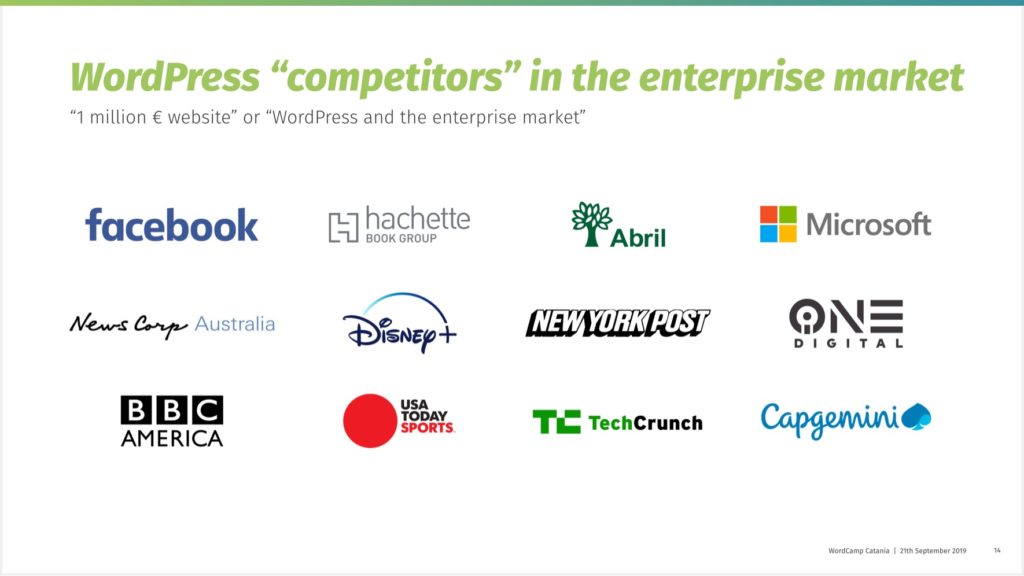
To answer the question left pending a while ago: “Is WordPress something from a shopping mall, or a skilled stylist?“ I can tell, it is neither.
WordPress is more like a cotton field. It can be harvested, put in the hands of a good textile company to make a quality fabric that a stylist can turn into a thousands-euros-worth suit. Or it can be harvested, mixed with 90% of acrylic to make a cheap fabric to be used for mass-produced-via-underpaid-labor 50 euro suits.
This comparison captures the huge flexibility of WordPress but also its “barebone” nature.
If in the current market there are thousands of companies very able to make cheap suits out of it, and millions of customers happily wearing them, the high-quality labor, skills, and instruments to turn it into an “elite” product are much more scarce.
One of the most voiced “selling points” of WordPress, probably the most appealing to many, is its huge ecosystem. However, as I argued before, when moved to the enterprise field, this ecosystem is not relevant for its biggest past. Meaning that “fighting” in the enterprise market is much harder for WordPress.
Not a secret, by the way
Gartner, Inc. is a global research and advisory firm with more than 15.000 employees worldwide. Among many other things, they are known for making a type of graph, called “magic quadrant”, where they place the top vendors for a given sector. They position vendors in the graph where the X-axis shows each vendor’s “completeness of vision” and the Y-axis their “ability to execute”.
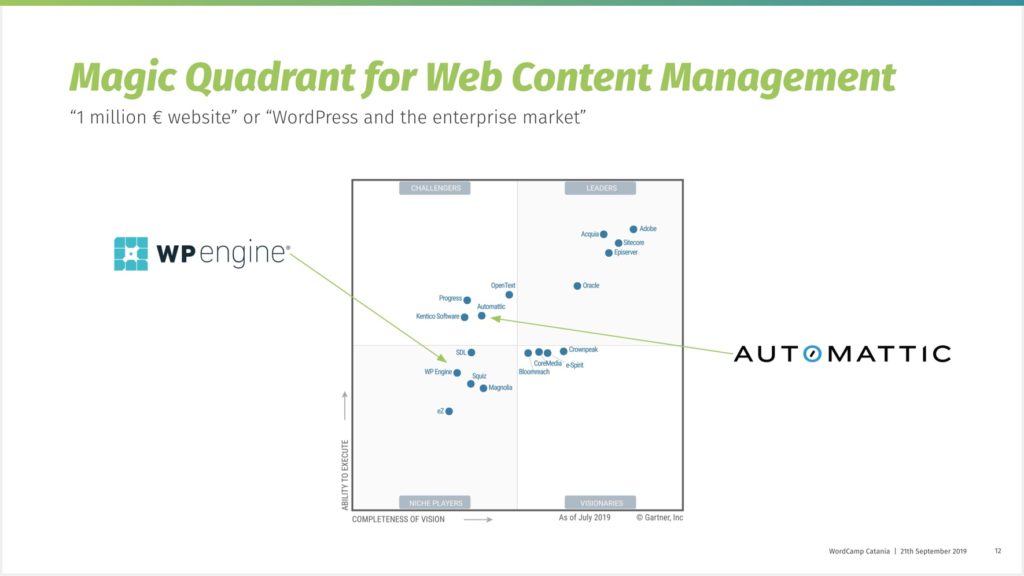
The result is a 4-parted graph, wherein clockwise direction from top-right, we can find the “leaders” of the market, the “visionaries”, the “niche players” and the “challengers”. The “magic quadrant” for “web content management” that was released by Gartner in 2019 shows two companies that can be related to WordPress (that is, choosing them as vendor the respective company ends up having a WordPress-based solution). Though WordPress is by far the most used CMS solution, none of them is in the “leaders” quadrant.
In the “challengers” quadrant, not even in the best position there, we find Automattic, the company that owns wordpress.com, and whose founder, CEO, and president is Matt Mullenweg, who is well-known in the WordPress community.
Given that we don’t take Gartner analysis for the absolute and unquestionable truth ‒ even if other consulting firms produce similar insights. What is clear is that WordPress dominance of the consumer and SME market does not apply to the big enterprises market, regardless of the adoption statistics.
Nobody, I think, could be surprised if Automattic would be looking at the enterprise market as the target of its growth.
Automattic and the Enterprise Market
Just a couple of days before I had my talk at WordCamp Catania, the news that Automattic received a 300 million funding from Salesforce Ventures came out.
Matt himself, in his announcement of the funding, made it quite clear that conquering the the enterprise market is one of the primary targets for the company. Surely, WordPress is not Automattic. But I think the influence on the business side of WordPress is quite clear.
For this reason, looking at the technologies that WordPress will compete in the enterprise market, might provide insights into some of the things that will happen to WordPress in the near future.
Features Enterprise clients demand
Even if the Gartner “magic quadrant” shows companies and not technologies, it is quite easy to understand which is the content management technology that those companies will offer to the clients who choose their services.
In some cases, the technology and the company are even homonyms. I have zero to very limited experience with those technologies. But that small experience combined with the information I could retrieve online, and more importantly, with the experience I have accumulated while working with enterprise clients in WordPress, made me compile a list of what I think are the “areas” in which WordPress is lagging behind the competition:
Authentication
No big company ever will let administrators or editors login via username and password. All enterprises have centralized credential management systems that are built to integrate with other platforms, using standards like OpenID Connect or SAML. Ready-made solutions to integrate with such standards are non-existing for WordPress. Solutions that can be found online are, in the very best case, something that can be used as a “fork” base for a customized solution. WordPress competitors make such integration a simple routine.
Multi-language
Big companies are global and of course need global websites. Unfortunately multilingualism is not in the core of WordPress yet. But luckily planned in later versions of WordPress. Also, there are some experts out there who work hard on making multilingualism possible for WordPress. Like we do, with our multilingual plugin MultilingualPress.
Multi-tenancy
Often, big companies consist of smaller companies or one main “parent” company has several “child” companies. In such cases, a consistent and at the same time flexible “web properties” management solution is required. WordPress multisite is not a solution for different reasons: Users share accounts (something that might even be against law), or there’s no way to have, for example, a different version of a given plugin in two different properties. Not to mention that sometimes a multisite installation is already required for one of the companies, so it would be needed a multisite of multisites, something that is not possible by only using the core.
Multi Environment
Every website that can be considered barely professional will have at least a “staging environment”. That is a website identical to the main website, but not accessible for public.
This environment is used by the company to test features and content before they go online publicly. It is a standard requirement that content and configurations done in this staging environment are moved seamlessly to the “production” environment. WordPress does not have this feature. To be honest, it is hard or even impossible to do this properly on WordPress sites.
User segmentation
In WordPress, we have user “roles”, but normally, clients of a company all have the same role because they can’t change anything on the website, except of their password.
However, many companies benefit a lot from showing different content to different kinds of users. Imagine a restaurant chain website. Wouldn’t they want to display different content to their customers based on their favorite dishes?
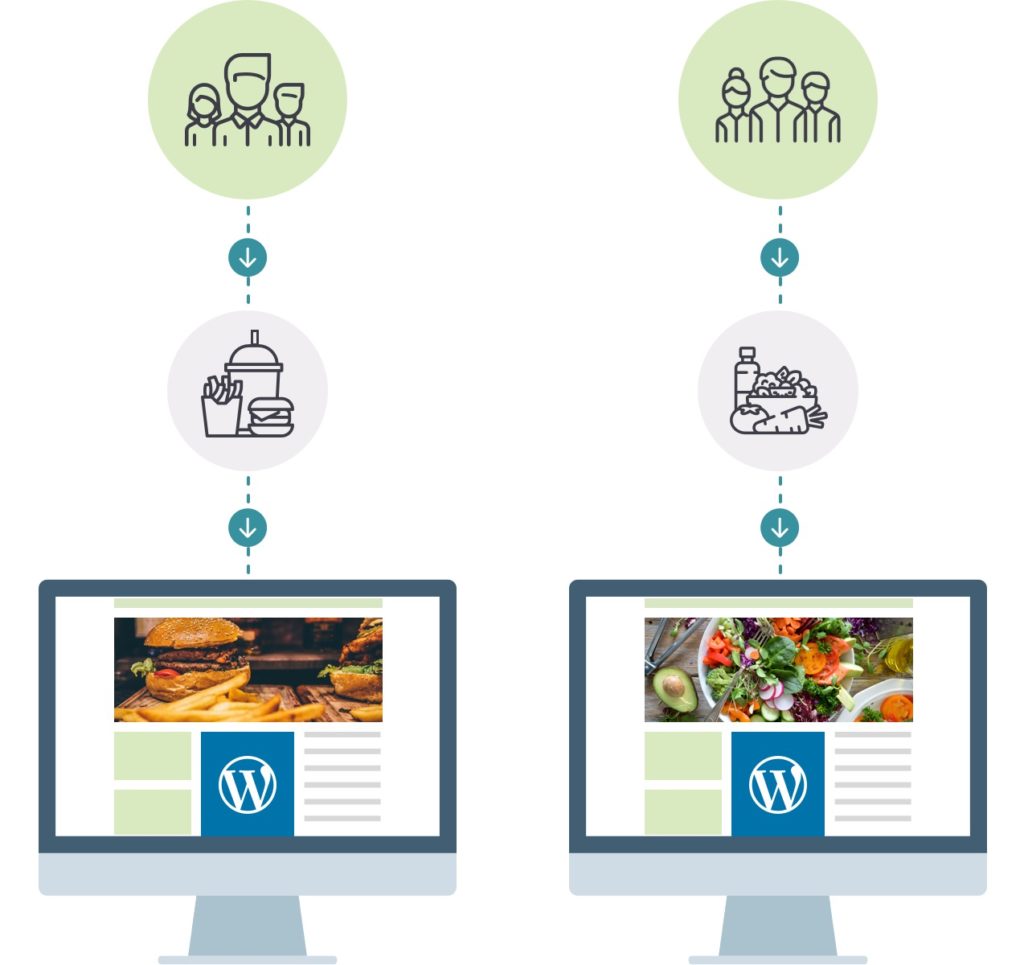
Distributed content creation
In WordPress, only a single user can edit the same post at the same time. Possibility for simultaneous editing by multiple users is available on many platforms. But not in WordPress at the moment.
Moreover, despite being born and raised as a blog publishing tool, WordPress cannot even assign multiple authors to a piece of content. Not to talk about the “editorial flow” for content, that has been an issue for news companies using WordPress ever since.
Hopefully these collaboration features will come in 2020.
Integration
We live in a world that is every day more digital and more integrated. Thinking that an important piece of corporate business, like an online content management system, could live isolated from other as-important pieces is, at best, naive. The REST API has been a step forward for WordPress, but that is raw material. Companies want ready-made and working solutions. WordPress competitors have a lot of either core or official integrations with tools that are commonly used in enterprises. WordPress has very few.
For example: A web search for WordPress integration with accounting tools that are popular among freelancers gives dozens of results; but a search for integration with some of the most popular financial or logistic tools that are popular among enterprises gives often zero results.
A lack of enterprise tools integration is probably the main weakness of WordPress compared to the competition in that market. Even because, companies want more than “just” a CMS.
Experience … what?
When I showed the slide with “WordPress competitors” logos, someone might have noticed that some of them have the word “experience” somewhere in the name or the tagline.
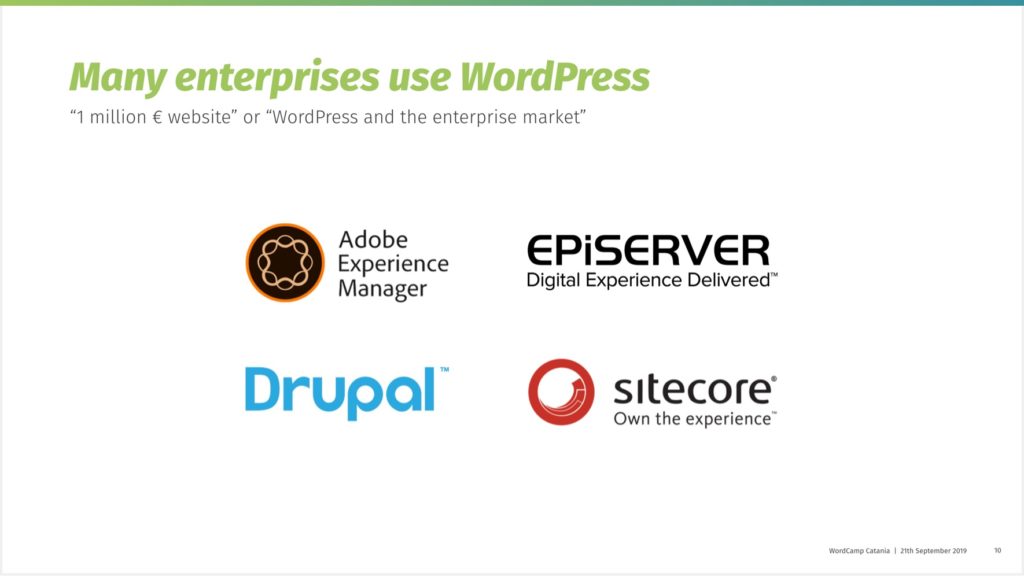
This is the result of a recent re-branding coming from the raising popularity of a new term: Digital Experience Platform or DXP.
Besides the various definitions, a DXP is (or should be) the result of the modern way of consuming digital content that has long left the computer as medium to enter the life of a person in every moment and place. Thanks to the “smart” things we all have and use: phones, speaker, wearables.
But also the way we consume entertainment such as audio and video is not our grandparents’ TV and radio.
On top of that, the capability to collect and store huge amount of data, and the chance to process it using machine learning, has given enterprises the possibility (and the desire) to offer their customers a “total and engaging experience”, that is truly personalized and dynamic.
The term DXP itself is circulating marketing quarters since a few years already. But it entered the “WordPress bubble” not until the last few months.
After DXP entered the WordPress ecosystem, I started searching for DXP material online, but no matter who was the source: Everything sounded like nothing more than marketing buzzwords jumble to me.
I started figuring out by imagining what a DXP is like in the real world. I will try to do the same with you.
Let’s imagine a big retail group, ThatBigRetail, and a fictional customer of them, Jane. She, like thousands of other customers, has an “loyalty card” that she swipes at the cash register to obtain discounts and offers. Thanks to that, ThatBigRetail knows what she is buying.
That, combined with the information she gave to obtain the card (address, age…) enables them to create a profile for her.
With some not-so-advanced machine learning, the retail company now knows that Jane is vegetarian and loves a particular brand of beer. The last newsletter, she received from the ThatBigRetail marketing department, featured an article about all the “vegan-certified” breweries that sell their products in the retail chain shops.
Clicking on a link on that email, she landed on the company website, and there she sees prominent banners featuring vegan products (note: she is not logged-in).
While on the website, she searched for “coconut ice cream”, just to see if that’s available. The day after, she goes to a ThatBigRetail shop, and when she pays the cash machine spits out a coupon for some vegan coconut ice cream.
To claim the coupon, she needs to install an app on the phone (which can also replace the plastic loyalty card; it is 2020, after all). The app Jane installed recognizes when she enters the retail group shops and shows notifications with just-arrived products and deals, only for products Jane searched, bought online, shown interest in some way, or the ThatBigRetail machine learning algorithms thinks she might be interested in.
One day, Jane enters the shop. The data collected via the loyalty card tells ThatBigRetail that she has not bought her favorite beer for three weeks in a row and that she bought twice some folic acid supplement instead. Just the time she gets home, she receives an email with the best deals for cribs and strollers.
This fictional story is not a dystopian future, but kind-of-boring past. Companies want to leverage every “touchpoint” with customers on websites, mobile applications, emails, wearables, smart home appliances… anything in a never-ending digital relationship.
A DXP is, in theory, a platform that offers all the tools to do that, also integrating any service that a company is using, both customer-facing and internal (like documents and logistics management).
Experience … environment?
Many people in the industry have doubts that such a platform exists. Some of them have a very strong opinion about DXP not being a thing.
What is undeniable is that the “promises” of DXP are something that is already reality, something that many companies are actively putting into practice (since years) and many others are looking forward to.
However, many analysts say ‒ and I agree, for what it counts ‒ that the all-encompassing digital experience, so appealing to enterprises, is not to be found in a single platform, but more in an environment, composed by many platforms, provided by many vendors, that shares information via standardized communications channels, each using as input the output of the other, and all of them being fueled by the data that customers produce when consuming the services those platforms offer.
In such a “digital experience environment”, WordPress has surely the chance to become more relevant for the enterprise sector.
Many signals, like the upcoming of DXP in the WordPress bubble, the launch of the Open Source Digital Experience Platform, or the millionaire funding received by Automattic, point to a near future in which part of its ecosystem aims at making WordPress the optimal solution for the highly integrated, highly personalized and highly dynamic content management platform that enterprises demand.

Looking into the future of WordPress
If fulfilling the demands of the enterprise market is the goal, the biggest obstacles are not to be searched in WordPress itself. The planned WordPress future (or the next “Gutenberg phases”, if you prefer) are already scheduled to address some of the “weakness” I identified above. And generally speaking, the “app-ification” of the WordPress back-office and its move towards an API-first approach will make many of the user-centric innovation easier.
In the right hands, WordPress is a powerful CMS for enterprise clients.
The greatest challenge I see for the whole ecosystem is how to meet the needs of the huge and varied user base, and of the market that has that user base as target, with the desire to be more appealing to enterprises.
For the developers, the biggest challenge will probably be to understand how to conciliate this strain towards change and embracing of new technologies.
In conclusion, for those interested in the business side of the topic, this might be the perfect time to get on the wagon (before it’s too crowded) and become the company that will sell the next 1 million euros WordPress website.
What is your opinion on that? I would love to hear from you on Twitter (@gmazzap), my personal Website, or to chat with you at the next WordCamp!
This blog was originally a speech of our colleague Giuseppe Mazzapica on the WordCamp Catania in September 2019. It contains spoken word and is a long read. But it’s totally worth it.